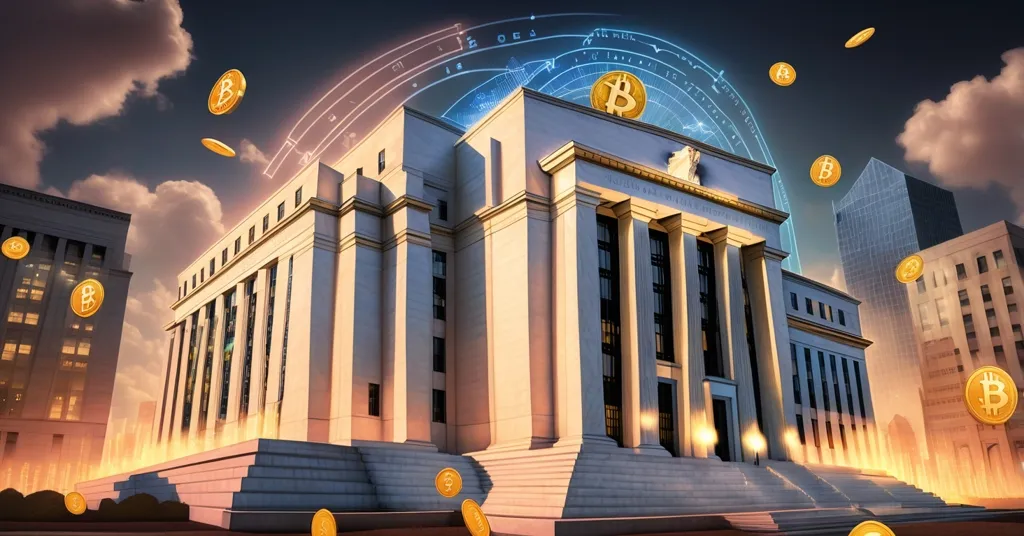Fed Rate Cut Speculation: Crypto Rally Trigger or Economic Red Flag?

FED Rate Cuts This Week: A Crypto Rally Ignition or Economic Warning Sign?
The financial world is holding its breath as the Federal Reserve’s July 29–30 FOMC meeting approaches, with whispers of a surprise interest rate cut stirring excitement and unease alike. Could a policy pivot send Bitcoin and other cryptocurrencies soaring, or is this a red flag for deeper economic troubles? Let’s unpack the hype, the risks, and what it means for the crypto space.
- Rate Cut Odds: Markets see just a 24% chance of a July cut, with 81% banking on September, while Polymarket traders bet 96.3% on rates holding at 4.25%–4.5%.
- Crypto Potential: Lower rates could fuel a rally in Bitcoin, Ethereum, and altcoins, but inflation and economic weakness loom as spoilers.
- Broader Stakes: Stocks and real estate might surge, yet the Fed’s motive—growth or panic—could flip market sentiment overnight.
The Bull Case: Liquidity as Crypto Rocket Fuel
A surprise rate cut by the Federal Reserve could be the shot in the arm that risk assets like cryptocurrencies desperately need. Lower interest rates mean cheaper borrowing, which often pushes investors away from low-yield safe havens like bonds and into speculative plays—think Bitcoin, currently trading between $60,000 and $70,000 (forget those wild $116K fantasies floating around), and Ethereum, sitting at $3,600 to $3,871. When money gets cheap, folks have more to splash on high-risk, high-reward assets like digital currencies. Crypto analyst Paul Barron has suggested that a cut could spark massive rallies not just in crypto but across stocks, tech, and real estate. Historically, the S&P 500 has climbed 86% of the time within 12 months after a rate cut, and crypto often rides that wave of optimism.
Pro-crypto advocate John E. Deaton doubles down on this, arguing that easier monetary policy could significantly lift asset prices, especially in our corner of the market. With the total crypto market cap still stuck below $4 trillion, lacking a real catalyst, a Fed move might just light the fuse. Picture this: retail investors jumping back into Bitcoin ETFs, institutions scooping up altcoins like XRP and ADA during dips, all fueled by access to cheap capital. A weaker dollar post-cut could also boost trading volumes in emerging markets, where decentralized finance (DeFi) already serves as a lifeline against shaky local currencies. For Bitcoin maximalists, this is a chance to see BTC cement its role as digital gold; for altcoin fans, it’s fuel for innovation in niches Bitcoin doesn’t touch. If you’re curious about how rate cuts could trigger a crypto rally, the potential upside is hard to ignore.
The Bearish Flip: Inflation and Economic Alarm Bells
Before we start planning our moon landings, let’s slam the brakes. The market isn’t exactly buzzing with confidence—only 24% of traders expect a cut this week, compared to 81% eyeing September, per recent data. On Polymarket, a prediction platform that often gauges speculative sentiment, a whopping 96.3% bet rates will stay put at 4.25%–4.5% through the FOMC meeting. This doubt isn’t just noise; it reflects real uncertainty about the Fed’s upcoming decision. Is this about fostering growth, or are they scrambling to fix a crumbling economy?
The risks are stark. Inflation, still at 2.7% against a 2% target as of May, could roar back if wage growth keeps outpacing productivity. Ever heard of a “wage-price spiral”? It’s a nasty loop where rising wages drive up prices, which then demand even higher wages, making inflation a stubborn beast. With unemployment below 4%, cutting rates now might signal desperation rather than strategy, risking stagflation—a grim combo of stagnant growth and rising costs that no amount of HODLing can dodge. Fed officials like Atlanta President Raphael Bostic have flagged that cutting too early could bake inflation into consumer mindsets, while potential tariff hikes down the road might make things messier. If markets sniff panic in the Fed’s move, sentiment could tank faster than a rug-pulled altcoin. For a deeper look at how rate cuts might impact Bitcoin, community discussions highlight mixed sentiments.
Inside the Fed: A House Divided
The Federal Open Market Committee (FOMC), the Fed’s policy-setting crew, is wrestling with its own internal drama. Governor Chris Waller is pushing for a July cut, pointing to private-sector job growth slowing to “near stall speed” and arguing for preemptive action to prop up the labor market. He shrugs off tariff-driven price spikes as temporary blips. But most Fed officials, including Chair Jerome Powell, seem fine with waiting, sticking to a “show me the data” stance. Powell’s post-meeting press conference could be just as critical as any decision—subtle nods to cuts in Q3 or Q4 might still pump crypto sentiment, even if July passes quietly. Meanwhile, political noise, like former President Donald Trump’s calls for immediate cuts, adds heat, though Polymarket odds on rate decisions peg Powell’s ousting at a slim 1%–17% through 2025. Central bank independence looks safe, for now.
Lessons from History: Bitcoin and Fed Moves
History offers some clues on how crypto might react to Fed policy, though it’s no crystal ball. Back in 2019, when the Fed slashed rates amid trade war jitters, Bitcoin surged from around $4,000 in March to over $13,000 by June, fueled by liquidity and risk appetite. Contrast that with 2022, when aggressive rate hikes to combat inflation crushed risk assets—Bitcoin plummeted from $69,000 to under $17,000 in months. The lesson? Lower rates often juice crypto, but context matters. Today’s market is more mature, with institutional players and ETFs in the mix, so reactions might be less wild. Plus, if a cut signals economic weakness, as in 2008’s early moves before the crash, risk assets—including our beloved BTC—could still bleed. Bitcoin isn’t always the inflation hedge maximalists claim; sometimes, it’s just another pawn in macro games. Check out more on Bitcoin’s response to Fed policy shifts for historical context.
Stablecoins and DeFi in the Fed’s Shadow
Beyond price pumps, a rate cut could ripple through decentralized finance (DeFi) and stablecoins, cornerstones of the crypto ecosystem. Stablecoins like USDT and USDC, pegged to the USD, might face subtle pressure if a weaker dollar shifts global forex dynamics. Borrowing rates in DeFi protocols, often tied to traditional finance benchmarks, could drop, spurring leveraged plays—but beware, low rates can also breed over-leveraging, a recipe for liquidations if sentiment flips. For the uninitiated, DeFi is a blockchain-based financial system cutting out middlemen like banks, offering lending, borrowing, and more via smart contracts. A liquidity boost could supercharge DeFi adoption, yet it risks mirroring traditional finance’s worst excesses if not handled with caution. For insights into crypto trends during rate cut cycles, the data shows both opportunity and risk.
Global Angle: Crypto as a Lifeline
Fed policy doesn’t stop at U.S. borders. A rate cut weakening the dollar could turbocharge crypto adoption in emerging economies battling inflation or currency devaluation—think Latin America or parts of Africa, where Bitcoin and stablecoins already act as financial escape hatches. Cheaper USD-denominated borrowing might drive more locals to crypto exchanges, hedging against their own crumbling fiat. Yet, this cuts both ways: if inflation fears spike post-cut, global risk-off sentiment could hit these markets hardest, dragging crypto down with it. For decentralization purists, this is a stark reminder of Bitcoin’s roots—born to sidestep centralized money meddling, yet still tethered to Fed whims in 2023. Isn’t it time we built systems that don’t flinch at Powell’s every word? If you’re wondering how Fed rate cuts influence crypto markets, global perspectives add another layer to the debate.
What to Watch For
As the FOMC meeting wraps, keep eyes peeled for Powell’s tone—any hint of future easing could keep crypto’s cautious optimism alive, even without a July cut. September’s odds, sitting at 81%, loom as the next big trigger, alongside fresh inflation and employment data that could sway the Fed’s hand. For Bitcoin and altcoin traders, this week might just be another sideways grind unless a surprise drops. But let’s not kid ourselves: while we obsess over central bank crumbs, blockchain’s real promise is building a table of our own. Crypto isn’t just about reacting to the Fed—it’s about dismantling their stranglehold on money. Let’s accelerate that future, not just bet on their next move. For a primer on how Federal Reserve rate cuts work, understanding the mechanics can clarify their broader impact.
Key Questions and Takeaways for Crypto Enthusiasts
- How could a Federal Reserve rate cut impact Bitcoin and Ethereum prices?
A cut could drive prices up by making borrowing cheaper, pushing investors into risk assets like Bitcoin and Ethereum. More liquidity often fuels speculative buying, potentially lifting market sentiment and trading volumes.
- Why is there so much skepticism about a July rate cut?
Markets assign only a 24% chance for July versus 81% for September, and Polymarket traders see a 96.3% likelihood of no change, reflecting doubts about the Fed’s readiness to act amid inflation concerns.
- What risks come with a surprise rate cut for the crypto market?
Inflation could spike if wages outpace productivity, creating a wage-price spiral. A cut signaling economic weakness might also trigger panic, tanking risk assets like crypto despite initial liquidity boosts.
- How might Fed policy affect stablecoins and DeFi platforms?
Stablecoin pegs tied to the USD could wobble with a weaker dollar, while lower DeFi borrowing rates might spur activity—but also risk over-leveraging, inviting liquidations if markets turn sour.
- Can Bitcoin truly break free from Federal Reserve influence?
Not yet—crypto remains tied to macro trends like Fed decisions, despite its decentralized ethos. True independence demands wider adoption of self-custody and DeFi, reducing reliance on traditional finance cues.



